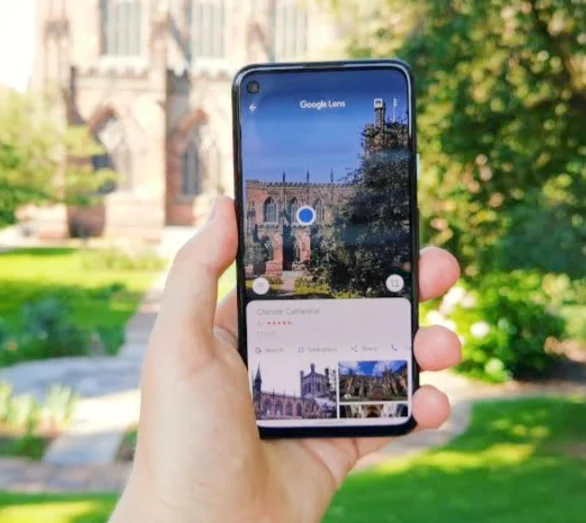Google Lens: Search the World with Your Camera
Google Lens is a powerful image recognition technology that uses your smartphone's camera to understand and interact with the world around you. It goes beyond simply taking pictures, allowing you to search for information, translate text, identify objects, and more, all visually.
What Can Google Lens Do?
| Feature | Description |
|---|---|
| Search with your camera | Point your camera at an object and Lens will identify it, providing relevant search results, webpages, or information. |
| Copy and translate text | Instantly copy text from physical objects like signs, documents, or packaging. Lens can also translate text in real-time over 100 languages. |
| Identify plants and animals | Ever come across an unfamiliar flower or creature? Lens can help you identify them and learn more about their characteristics. |
| Explore places and menus | Use Lens to scan restaurant menus or landmarks to get reviews, ratings, and other helpful information. |
| Shop for products | See something you like in real life? Lens can help you find similar products online for purchase. |
| Find visually similar images | Upload an image or use your camera to find similar images on the web. |
How Does Google Lens Work?
Google Lens leverages machine learning and image recognition to analyze what you're looking at through your camera. It compares objects in your image to a vast database and identifies them based on similarity. Lens also uses its understanding of the objects to find relevant information from the web.
Where to Find Google Lens
Google Lens is available on various platforms, including:
- The Google app (Android and iOS)
- Google Chrome web browser (desktop and mobile)
- Some Android smartphones directly through the camera app
By utilizing the power of your camera and Google Lens's intelligent capabilities, you can unlock a world of information and simplify everyday tasks.
Specific Technologies Powering Google Lens
Google Lens utilizes a combination of cutting-edge technologies to deliver its impressive image recognition and interaction capabilities. Here's a breakdown of some key ones:
-
Deep Learning: At the core of Lens lies deep learning, a subfield of machine learning inspired by the structure and function of the human brain. Deep learning models are trained on massive amounts of labeled data, allowing them to identify patterns and relationships in images with remarkable accuracy. In Google Lens, these models analyze the object in your camera view, recognizing its shape, texture, and other visual characteristics.
-
Image Recognition: Image recognition is the fundamental ability of Google Lens to understand what it "sees." Deep learning models are trained on vast datasets of images and their corresponding labels. When you point your camera at an object, Lens compares the image to its database and identifies the most likely match.
-
Object Detection: This technology goes beyond simple identification. Object detection allows Lens to not only recognize objects but also pinpoint their location within the image frame. This enables features like copying specific text from a document or identifying plants within a landscape picture.
-
Optical Character Recognition (OCR): OCR is crucial for text-related functionalities in Lens. It allows the technology to extract text from images, such as signs, documents, or business cards. By recognizing individual characters and understanding their arrangement, Lens can convert the text into a digital format for copying, translation, or web searches.
-
Machine Translation: Google Lens integrates machine translation to break down language barriers. When you point your camera at foreign text, Lens can translate it into your preferred language in real-time, making communication and information access seamless.
-
Web Search and Information Retrieval: Google Lens leverages Google's powerful search engine to provide contextually relevant information about the objects it identifies. Based on the identified object and its visual context, Lens retrieves information from the web, such as product details, business reviews, plant descriptions, or historical landmarks.
These technologies work together to create a sophisticated system that bridges the gap between the physical world and the digital realm. By understanding the specific technologies behind Google Lens, you gain a deeper appreciation for its capabilities and how it can enhance your everyday interactions with the world around you.
Companies Utilizing Google Lens Technology
While Google Lens is a consumer-facing product, its underlying technology can be valuable for businesses as well. Here's a table outlining how some real companies are leveraging Google Lens:
| Company Type | Project Name | Benefit |
|---|---|---|
| Retail | Sephora Virtual Artist | Sephora uses Google Lens technology in its mobile app to allow customers to virtually try on makeup products. By pointing their phone camera at their face, users can see how different lipstick shades, eyeshadow colors, and other makeup would look on them before purchasing. This personalized experience can increase customer satisfaction and sales. |
| Travel & Hospitality | BMW Museum Tour with Google Lens | The BMW Museum in Munich, Germany, has integrated Google Lens into its exhibits. Visitors can use their smartphones to scan designated points of interest throughout the museum. Lens then displays relevant information, historical context, or even 3D models of vehicles on the visitor's phone screen, enriching the museum experience. |
| Education McGraw-Hill Connect with Google Lens | McGraw-Hill, a leading educational publisher, has incorporated Google Lens compatibility into its Connect learning platform. Students using McGraw-Hill textbooks with embedded Lens codes can scan these codes to access interactive quizzes, multimedia resources, or explainer videos directly on their phones. This technology enhances understanding and improves engagement with learning materials. | |
| Manufacturing & Assembly | Bosch Thermotechnology Service Assistant | Bosch Thermotechnology, a provider of heating and hot water systems, equips its service technicians with smartphones that leverage Google Lens. Technicians can scan error codes displayed on faulty equipment, and Lens retrieves relevant service manuals, troubleshooting guides, or even step-by-step repair instructions directly on their phones. This expedites repairs and improves service efficiency. |
| Ecommerce Amazon Style Snap | Amazon utilizes Google Lens technology in its mobile app through a feature called "Style Snap." Users can take a picture of a clothing item they like (in-store or elsewhere) and upload it to the Amazon app. Lens then searches for similar items available for purchase on Amazon, streamlining the shopping process and potentially increasing sales. |
Note: This table provides specific examples of companies leveraging Google Lens. As the technology advances, we can expect even more innovative applications to emerge across various industries.
Frequently Asked Questions for Google Lens
Google Lens is a powerful image recognition and search tool that allows you to instantly identify objects, text, and landmarks. Here are some common questions and answers:
General Questions
- What is Google Lens?
- Google Lens is an image recognition and search tool integrated into the Google app and Google Assistant. It uses artificial intelligence to identify objects, text, and landmarks in real-world images.
- How does Google Lens work?
- To use Google Lens, simply point your camera at an object or scene. Google Lens will analyze the image and provide relevant information, such as definitions, translations, or related searches.
- Can I use Google Lens offline?
- While Google Lens works best with an internet connection, some features, like object recognition and translation, can be used offline.
Technical Questions
- What devices are compatible with Google Lens?
- Google Lens is available on Android devices with the Google app or Google Assistant installed. It can also be used on iOS devices with the Google app.
- Can I use Google Lens on my computer?
- Currently, Google Lens is primarily designed for mobile devices. However, you can access Google Lens features through the Google app on your computer's web browser.
- Is Google Lens free to use?
- Yes, Google Lens is a free feature included with the Google app and Google Assistant.
Features and Benefits
- What can Google Lens do?
- Google Lens can:
- Identify objects, such as plants, animals, and landmarks
- Translate text into different languages
- Search for information related to images
- Provide definitions and explanations
- Copy and paste text from images
- Google Lens can:
- How can Google Lens benefit me?
- Google Lens can help you learn new things, translate text quickly, find information about products, and enhance your overall mobile experience.



